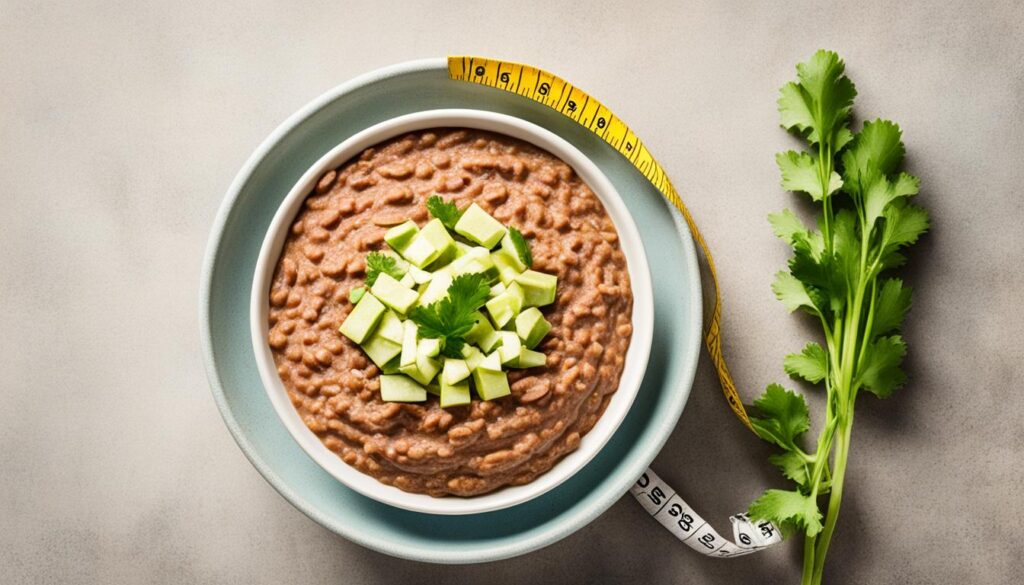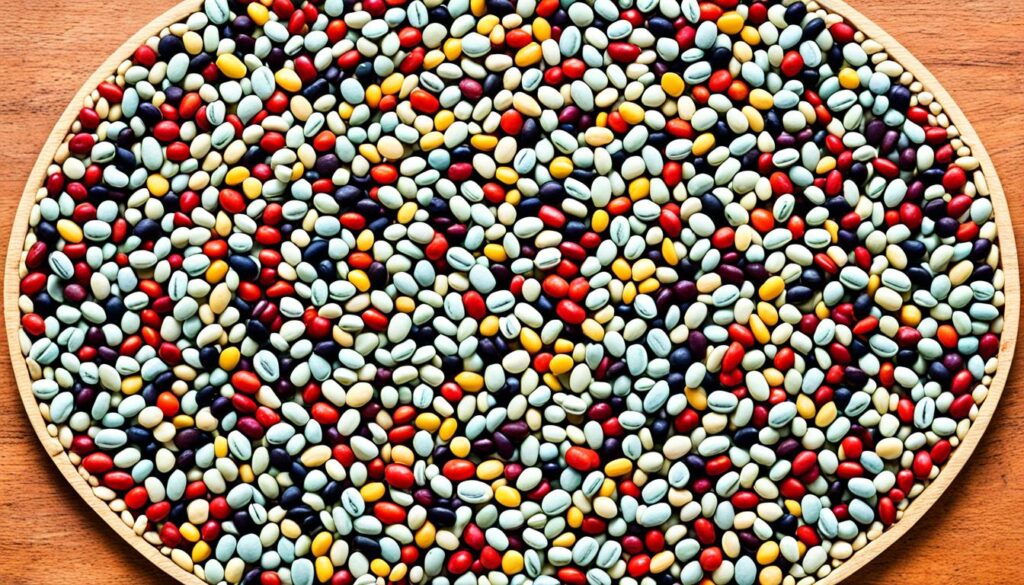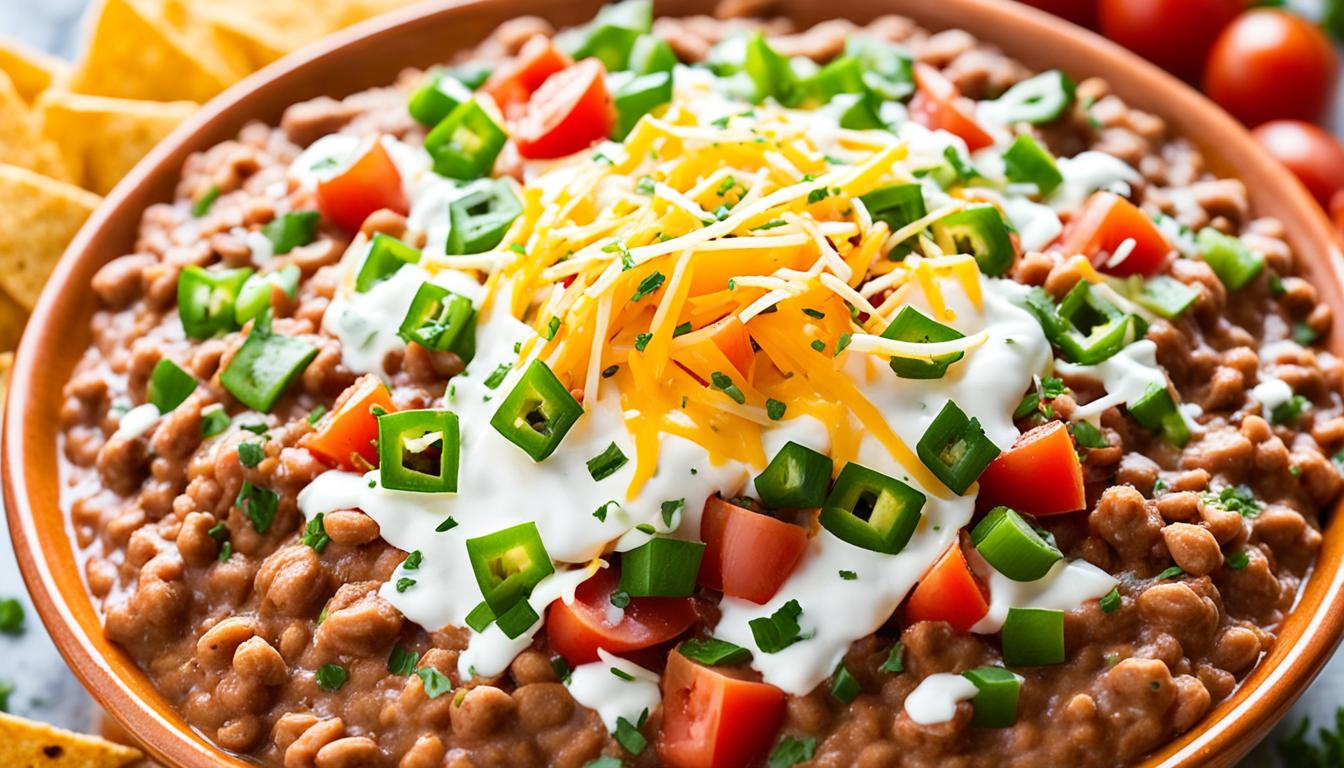“As an Amazon Associate I earn from qualifying purchases.” .
Have you ever wondered if refried beans are actually good for you? I must admit, I used to have my doubts. But after digging deep into the nutritional facts, I was pleasantly surprised by what I discovered.
Refried beans are not just a tasty addition to your Mexican cuisine, they are also packed with essential nutrients that can benefit your overall health. Whether you’re a health-conscious individual or simply curious about the nutritional value of refried beans, this article will unveil the truth behind their healthiness.
Refried beans contain a remarkable amount of protein, fiber, vitamins, and minerals that can contribute to a well-balanced diet. These small legumes pack a powerful nutritional punch that can support your overall health and well-being.
Key Takeaways:
- Refried beans are low in calories and high in nutrients, making them a healthy addition to your diet.
- They are a great source of protein, fiber, iron, magnesium, potassium, zinc, vitamin B6, and vitamin C.
- Refried beans offer various health benefits, including promoting gut health, reducing the risk of heart diseases, and aiding in blood sugar control for diabetics.
- However, it’s important to be mindful of portion sizes and avoid consuming refried beans prepared with lard or excessive sodium.
- By incorporating refried beans into a balanced diet, you can enjoy their nutritional benefits while maintaining overall health.
Health Benefits of Refried Beans
Refried beans offer a plethora of health benefits that make them a valuable addition to a balanced diet. These delicious legumes are packed with essential nutrients and compounds that promote overall well-being.
Protection against Age-Related Illnesses
Refried beans are rich in polyphenols, which are powerful antioxidants. These compounds help protect against age-related illnesses such as cancer and metabolic disorders. By consuming refried beans regularly, you can boost your body’s defense against harmful free radicals and reduce the risk of developing chronic diseases.
Improved Gut Health
The high fiber content of refried beans is beneficial for promoting good gut health. Fiber acts as a prebiotic, supporting digestion and providing nourishment for beneficial gut bacteria. By incorporating refried beans into your diet, you can enhance the balance of your gut microbiota and support optimal digestion.
Promotion of Feeling of Fullness
Refried beans are a great addition to a weight management plan as they promote a feeling of fullness. The combination of fiber, protein, and complex carbohydrates in refried beans helps to regulate appetite and prevent overeating. Including refried beans in your meals can assist in controlling portion sizes and managing weight more effectively.
Reduced Risk of Heart Diseases
Thanks to their low glycemic profile and abundant source of magnesium and potassium, refried beans can contribute to a reduced risk of heart diseases. The low glycemic index of refried beans means they have a minimal impact on blood sugar levels, which is beneficial in preventing cardiovascular issues. Additionally, the high magnesium and potassium content in refried beans supports heart health by regulating blood pressure and reducing the risk of stroke.
Regulation of Blood Glucose Levels
Refried beans have a low glycemic profile, making them a suitable option for regulating blood glucose levels. This is particularly advantageous for individuals with diabetes or those at risk of developing the condition. Including refried beans in a balanced meal plan can help stabilize blood sugar levels and improve overall glycemic control.
Refried beans offer numerous health benefits, including protection against age-related illnesses, improved gut health, promotion of the feeling of fullness, reduced risk of heart diseases, and regulation of blood glucose levels. By incorporating refried beans into your diet, you can enjoy their nutritional advantages and support your overall health and well-being.
| Health Benefits | Description |
|---|---|
| Protection against Age-Related Illnesses | Rich in polyphenols, which are antioxidants that protect against cancer and metabolic disorders. |
| Improved Gut Health | High fiber content supports digestion and feeds beneficial gut bacteria. |
| Promotion of Feeling of Fullness | Fiber, protein, and complex carbohydrates help regulate appetite and prevent overeating. |
| Reduced Risk of Heart Diseases | Low glycemic profile and abundant magnesium and potassium reduce the risk of heart diseases. |
| Regulation of Blood Glucose Levels | Low glycemic index assists in stabilizing blood sugar levels and improving glycemic control. |
Diabetic-friendly Refried Beans
When it comes to managing diabetes, making wise food choices is crucial. This is where the diabetic-friendly nature of refried beans comes into play. Not only do refried beans have a low glycemic index, which means they have a minimal effect on blood sugar levels, but they also offer several benefits for diabetics.
One of the key factors that make refried beans suitable for diabetics is their high dietary fiber content. The fibers found in refried beans can bind with sugars and fats, reducing their absorption and utilization in the body. This can help prevent large spikes in blood sugar levels that are often associated with other high-carbohydrate foods.
Moreover, refried beans contain phenolic compounds, which have been shown to help reduce blood glucose and insulin levels. These compounds have a positive impact on blood sugar control, making refried beans an excellent choice for individuals with diabetes.
The protein content in refried beans also plays a role in blood sugar control. Protein helps slow down the rise of blood sugar levels after a meal, preventing sudden spikes. This can help diabetics maintain more stable blood sugar levels throughout the day.
Several studies have also shown that regular consumption of refried beans can help control blood glucose levels in diabetics and reduce the risk of developing type 2 diabetes. The combination of low glycemic index, dietary fibers, phenolic compounds, and protein makes refried beans a beneficial addition to a diabetic’s diet.
Tip:
When including refried beans in your diabetic meal plan, opt for homemade versions or those made with healthier ingredients. Avoid varieties prepared with lard or excessive sodium, as these can have negative effects on blood pressure and cholesterol levels. It’s also essential to monitor portion sizes, as consuming large amounts of refried beans can still impact blood sugar control.
Incorporating diabetic-friendly refried beans into your meals can not only add flavor and variety but also support your overall diabetes management. By combining them with other nutrient-dense foods and following a well-balanced diet, you can maintain stable blood sugar levels and enhance your overall health.

Side Effects of Eating Too Much Refried Beans
While refried beans have numerous health benefits, it’s important to be mindful of the potential side effects that excessive consumption can bring. Refried beans that are prepared with lard may contain saturated fat, which can contribute to raised blood cholesterol levels and increase the risk of heart disease. Additionally, refried beans can be relatively high in sodium, which has the potential to raise blood pressure levels.
Furthermore, beans themselves contain lectins, which are proteins that can be challenging to digest and may cause discomfort in the digestive system. However, there are ways to mitigate these potential side effects. Soaking and boiling beans can help to decrease the lectin content, making them easier to digest and reducing the chances of experiencing digestive difficulties.
Here are some potential side effects of eating too many refried beans:
- Raised Blood Cholesterol: Excessive consumption of refried beans prepared with lard can lead to increased levels of saturated fat, which may contribute to raised blood cholesterol levels.
- Increased Blood Pressure: Refried beans can be high in sodium, which has the potential to raise blood pressure levels when consumed in excess. It’s important to be mindful of your sodium intake if you’re concerned about blood pressure.
- Difficulty in Digestion: The lectins present in beans can be challenging to digest for some individuals, potentially causing discomfort in the digestive system.
Ultimately, enjoying refried beans as part of a balanced diet can contribute to a healthy lifestyle. It’s important to be aware of portion sizes and choose healthier preparation methods to minimize the potential side effects. By making informed choices and ensuring moderation, you can savor the nutritional benefits that refried beans have to offer while maintaining overall well-being.
Note: The image above is for illustrative purposes only and does not represent the specific side effects mentioned in the text.
Choosing the Healthiest Beans
When it comes to selecting the healthiest beans to eat, there are several nutritious options to consider. Incorporating beans into your diet can provide a wealth of essential nutrients and contribute to overall well-being.
Navy Beans
Navy beans are an excellent choice for promoting a healthy lifestyle. They are rich in fiber, protein, folate, and other essential nutrients that support various bodily functions. Including navy beans in your diet can help maintain a balanced nutrient intake.
Black Beans
Black beans are another standout among the healthiest beans to eat. They are a great source of fiber and protein, making them beneficial for weight loss and maintaining healthy blood sugar levels. Including black beans in your meals can help you feel satisfied and keep your blood sugar stable.
Garbanzo Beans (Chickpeas)
Garbanzo beans, also known as chickpeas, offer numerous health benefits. They are packed with nutrients that support heart health and help regulate blood sugar. Including garbanzo beans in your diet can contribute to a balanced and nutritious eating plan.
Kidney Beans
Kidney beans have a low glycemic index, making them suitable for regulating blood sugar levels. These beans are an excellent choice for individuals who need to manage their blood sugar as part of a healthy lifestyle.
Pinto Beans
Pinto beans are known for their high fiber content, making them excellent for promoting gut health. Including pinto beans in your diet can support digestion and contribute to overall well-being.
Lima Beans
Lima beans are rich in magnesium, potassium, and fiber, making them a great choice for supporting heart health and maintaining healthy cholesterol levels. Including lima beans in your meals can provide essential nutrients for cardiovascular wellness.
By incorporating the healthiest beans into your diet, such as navy beans, black beans, garbanzo beans, kidney beans, pinto beans, and lima beans, you can enjoy the nutritional benefits they offer. Whether you’re looking to support heart health, regulate blood sugar levels, or promote good digestion, these beans can be an excellent addition to your meals.

| Bean Type | Nutrition | Health Benefits |
|---|---|---|
| Navy Beans | Rich in fiber, protein, folate, essential nutrients | Supports overall well-being |
| Black Beans | High in fiber, protein | Promotes weight loss, healthy blood sugar levels |
| Garbanzo Beans | Packed with nutrients that support heart health, blood sugar control | Contributes to a balanced and nutritious diet |
| Kidney Beans | Low glycemic index, suitable for blood sugar regulation | Healthy option for managing blood sugar levels |
| Pinto Beans | High fiber content, excellent for gut health | Promotes digestion and overall well-being |
| Lima Beans | Rich in magnesium, potassium, fiber | Supports heart health, healthy cholesterol levels |
Healthy Cooking Methods for Refried Beans
When it comes to enjoying refried beans in a healthy way, there are several cooking methods and ingredient choices that can maximize their nutritional value. By making a few simple adjustments in the kitchen, you can transform refried beans into a nutritious and delicious addition to your diet.
Choose Plant-Based Oils:
Instead of using lard, opt for plant-based oils like extra virgin olive oil or canola oil to cook your refried beans. These oils are low in saturated fats and rich in heart-healthy monounsaturated fats, which can help maintain healthy cholesterol levels.
Reduce Salt Intake:
Excessive salt consumption can contribute to high blood pressure and other health issues. Instead of relying on salt for flavor, try using fresh or dried herbs like cilantro, cumin, or oregano to season your refried beans. Not only will this reduce your sodium intake, but it will also add delightful flavors and aromas to your dish.
Pair with Nutrient-Dense Foods:
To enhance the nutritional profile of refried beans, consider pairing them with other nutrient-dense foods. For example, serve refried beans with fresh salsa, which is rich in vitamins, minerals, and antioxidants. Alternatively, enjoy them with corn tortillas and a side of roasted or sautéed vegetables for a wholesome and well-balanced meal.
Remember, the key to healthy cooking is to choose ingredients and methods that maximize nutritional benefits without compromising on taste. With these simple adjustments, you can enjoy refried beans in a way that nourishes your body and tantalizes your taste buds.
| Healthy Cooking Methods for Refried Beans: | Benefits: |
|---|---|
| Use plant-based oils |
|
| Reduce salt intake |
|
| Pair with nutrient-dense foods |
|
Conclusion
After analyzing the nutritional facts and health benefits of refried beans, it can be concluded that they can be a healthy addition to your diet when prepared using healthy cooking methods and paired with nutrient-dense foods.
Refried beans offer various health benefits that include promoting gut health, reducing the risk of heart diseases, and aiding in blood sugar control for diabetics. Their rich fiber content and low glycemic profile make them suitable for individuals looking to maintain healthy blood glucose levels.
However, it is important to be mindful of portion sizes and avoid consuming refried beans prepared with lard or excessive sodium. These factors can negate the potential health benefits and contribute to negative effects on cholesterol levels and blood pressure.
By incorporating refried beans into a balanced diet, you can enjoy their nutritional benefits while maintaining overall health. Pair them with nutrient-dense foods like salsa, corn tortillas, and chopped vegetables to enhance the absorption of beneficial nutrients.
Remember to practice moderation and choose healthier cooking methods, such as using plant-based oils instead of lard and minimizing salt intake. By doing so, you can confidently include refried beans as a wholesome and nutritious part of your meals.
References
Here are some reputable sources that were referenced in this article:
- Brand-Miller, J., Hayne, S., Petocz, P., & Colagiuri, S. (2003). Low–glycemic index diets in the management of diabetes: a meta-analysis of randomized controlled trials.
- Jenkins, D. J., Kendall, C. W., McKeown-Eyssen, G., Josse, R. G., Silverberg, J., Booth, G. L., … & Leiter, L. A. (2008). Effect of a low–glycemic index or a high–cereal fiber diet on type 2 diabetes: a randomized trial.
- USDA FoodData Central.
- Ganesan, K., & Xu, B. (2017). Polyphenol-rich dry common beans (Phaseolus vulgaris L.) and their health benefits.
- Gullón, P., Gullón, B., Tavaria, F., Vasconcelos, M., & Gomes, A. M. (2015). In vitro fermentation of lupin seeds (Lupinus albus) and broad beans (Vicia faba): Dynamic modulation of the intestinal microbiota and metabolomic output.
- Li, S. S., Kendall, C. W., de Souza, R. J., Jayalath, V. H., Cozma, A. I., Ha, V., … & Sievenpiper, J. L. (2014). Dietary pulses, satiety and food intake: a systematic review and meta-analysis of acute feeding trials.
- Reverri, E. J., Randolph, J. M., Kappagoda, C. T., Park, E., Edirisinghe, I., & Burton-Freeman, B. M. (2017). Assessing beans as a source of intrinsic fiber on satiety in men and women with metabolic syndrome.
- Viguiliouk, E., Glenn, A. J., Nishi, S. K., Chiavaroli, L., Seider, M., Khan, T., … & Sievenpiper, J. L. (2019). Associations between dietary pulses alone or with other legumes and cardiometabolic disease outcomes: an umbrella review and updated systematic review and meta-analysis of prospective cohort studies.
- Venn, B. J., & Mann, J. I. (2004). Cereal grains, legumes and diabetes.
- Ou, S., Kwok, K. C., Li, Y., &.
FAQ
Are refried beans healthy?
What is the nutritional value of refried beans?
What are the health benefits of refried beans?
Can diabetics eat refried beans?
What are the side effects of eating too much refried beans?
Which beans are the healthiest to eat?
What are healthy cooking methods for refried beans?
Can you provide references for this article?
“As an Amazon Associate I earn from qualifying purchases.” .



